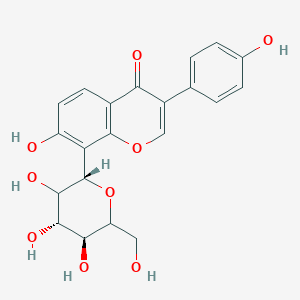| MeSH term | MeSH ID | Detail |
|---|---|---|
| Endometriosis | D004715 | 29 associated lipids |
| Ventricular Remodeling | D020257 | 28 associated lipids |
| Angina Pectoris | D000787 | 27 associated lipids |
| Brain Infarction | D020520 | 17 associated lipids |
| Angina, Unstable | D000789 | 14 associated lipids |
| Glucose Intolerance | D018149 | 13 associated lipids |
| Amnesia | D000647 | 12 associated lipids |
| Hypertension, Renovascular | D006978 | 10 associated lipids |
| Hepatitis, Alcoholic | D006519 | 5 associated lipids |
| Dyspepsia | D004415 | 5 associated lipids |
SCHEMBL105486
Kakonein is a lipid of Polyketides (PK) class. Kakonein is associated with abnormalities such as Fatty Liver, Chronic liver disease, Morphologically altered structure, Hypertensive disease and Cardiovascular Diseases. The involved functions are known as protein expression, Extravasation, Liver damage, mRNA Expression and cell activation. Kakonein often locates in Body tissue, Hepatic, Microvilli, Cytoplasm and Membrane. The associated genes with Kakonein are TJP1 gene, CD14 gene, iberiotoxin, AT-Rich Interactive Domain-Containing Protein 1A and NKS1 gene. The related lipids are dehydrosoyasaponin I and Steroids. The related experimental models are Knock-out.
Cross Reference
Introduction
To understand associated biological information of SCHEMBL105486, we collected biological information of abnormalities, associated pathways, cellular/molecular locations, biological functions, related genes/proteins, lipids and common seen animal/experimental models with organized paragraphs from literatures.
What diseases are associated with SCHEMBL105486?
SCHEMBL105486 is suspected in Chronic liver disease, Hypertensive disease, Cardiovascular Diseases, Myocardial Infarction, Cerebrovascular accident, Fatty Liver and other diseases in descending order of the highest number of associated sentences.
Related references are mostly published in these journals:
| Disease | Cross reference | Weighted score | Related literature |
|---|
Possible diseases from mapped MeSH terms on references
We collected disease MeSH terms mapped to the references associated with SCHEMBL105486
PubChem Associated disorders and diseases
What pathways are associated with SCHEMBL105486
There are no associated biomedical information in the current reference collection.
PubChem Biomolecular Interactions and Pathways
Link to PubChem Biomolecular Interactions and PathwaysWhat cellular locations are associated with SCHEMBL105486?
Visualization in cellular structure
Associated locations are in red color. Not associated locations are in black.
Related references are published most in these journals:
| Location | Cross reference | Weighted score | Related literatures |
|---|
What functions are associated with SCHEMBL105486?
Related references are published most in these journals:
| Function | Cross reference | Weighted score | Related literatures |
|---|
What lipids are associated with SCHEMBL105486?
Related references are published most in these journals:
| Lipid concept | Cross reference | Weighted score | Related literatures |
|---|
What genes are associated with SCHEMBL105486?
Related references are published most in these journals:
| Gene | Cross reference | Weighted score | Related literatures |
|---|
What common seen animal models are associated with SCHEMBL105486?
Knock-out
Knock-out are used in the study 'MATE2 mediates vacuolar sequestration of flavonoid glycosides and glycoside malonates in Medicago truncatula.' (Zhao J et al., 2011).
Related references are published most in these journals:
| Model | Cross reference | Weighted score | Related literatures |
|---|
NCBI Entrez Crosslinks
All references with SCHEMBL105486
Download all related citations| Authors | Title | Published | Journal | PubMed Link |
|---|---|---|---|---|
| Feng CG et al. | [Progress in research of aldose reductase inhibitors in traditional medicinal herbs]. | 2005 | Zhongguo Zhong Yao Za Zhi | pmid:16335816 |
| Tian H et al. | [Separation and identification of isoflavonoids in Pueraria lobata extracts and its preparations by reversed-phase capillary liquid chromatography coupled with electrospray ionization quadrupole time of flight mass spectrometry]. | 2005 | Se Pu | pmid:16350789 |
| Kirakosyan A et al. | Isoflavone levels in five soybean (Glycine max) genotypes are altered by phytochrome-mediated light treatments. | 2006 | J. Agric. Food Chem. | pmid:16390177 |
| Zhou PQ et al. | [Clinical observation of puerarin in treating patients with vertebral artery insufficiency due to cervical spondylosis: a report of 123 cases]. | 2006 | Zhong Xi Yi Jie He Xue Bao | pmid:16409979 |
| Delmonte P et al. | Determination of isoflavones in dietary supplements containing soy, Red Clover and kudzu: extraction followed by basic or acid hydrolysis. | 2006 | J Chromatogr A | pmid:16413562 |
| Ren F et al. | Quantitative determination of puerarin in dog plasma by HPLC and study on the relative bioavailability of sustained release tablets. | 2006 | J Pharm Biomed Anal | pmid:16413737 |
| Zhang S et al. | Reversal of chemical-induced liver fibrosis in Wistar rats by puerarin. | 2006 | J. Nutr. Biochem. | pmid:16426832 |
| Gao Q et al. | Atractyloside and 5-hydroxydecanoate block the protective effect of puerarin in isolated rat heart. | 2006 | Life Sci. | pmid:16458326 |
| Weiping S et al. | Self-assembly of an amphiphilic derivative of chitosan and micellar solubilization of puerarin. | 2006 | Colloids Surf B Biointerfaces | pmid:16466908 |
| He HJ et al. | [Effects of sucrose and light on the growth and production of secondary metabolites in Pueraria phaseoloides hairy roots]. | 2005 | Sheng Wu Gong Cheng Xue Bao | pmid:16468362 |
